+ Open data
Open data
- Basic information
Basic information
| Entry | Database: PDB / ID: 2lnl | ||||||
|---|---|---|---|---|---|---|---|
| Title | Structure of human CXCR1 in phospholipid bilayers | ||||||
 Components Components | C-X-C chemokine receptor type 1 | ||||||
 Keywords Keywords |  SIGNALING PROTEIN / SIGNALING PROTEIN /  G protein coupled receptor / G protein coupled receptor /  GPCR / GPCR /  chemokine / chemokine /  membrane protein / membrane protein /  transmembrane / 7TM / transmembrane / 7TM /  phospholipid / phospholipid /  signaling signaling | ||||||
| Function / homology |  Function and homology information Function and homology information interleukin-8 receptor activity / interleukin-8 receptor activity /  interleukin-8 binding / interleukin-8 binding /  chemokine receptor activity / C-C chemokine receptor activity / C-C chemokine binding / Chemokine receptors bind chemokines / dendritic cell chemotaxis / chemokine receptor activity / C-C chemokine receptor activity / C-C chemokine binding / Chemokine receptors bind chemokines / dendritic cell chemotaxis /  neutrophil chemotaxis / secretory granule membrane / G protein-coupled receptor activity ... neutrophil chemotaxis / secretory granule membrane / G protein-coupled receptor activity ... interleukin-8 receptor activity / interleukin-8 receptor activity /  interleukin-8 binding / interleukin-8 binding /  chemokine receptor activity / C-C chemokine receptor activity / C-C chemokine binding / Chemokine receptors bind chemokines / dendritic cell chemotaxis / chemokine receptor activity / C-C chemokine receptor activity / C-C chemokine binding / Chemokine receptors bind chemokines / dendritic cell chemotaxis /  neutrophil chemotaxis / secretory granule membrane / G protein-coupled receptor activity / calcium-mediated signaling / neutrophil chemotaxis / secretory granule membrane / G protein-coupled receptor activity / calcium-mediated signaling /  receptor internalization / positive regulation of cytosolic calcium ion concentration / G alpha (i) signalling events / cell surface receptor signaling pathway / receptor internalization / positive regulation of cytosolic calcium ion concentration / G alpha (i) signalling events / cell surface receptor signaling pathway /  immune response / G protein-coupled receptor signaling pathway / external side of plasma membrane / Neutrophil degranulation / immune response / G protein-coupled receptor signaling pathway / external side of plasma membrane / Neutrophil degranulation /  plasma membrane plasma membraneSimilarity search - Function | ||||||
| Biological species |   Homo sapiens (human) Homo sapiens (human) | ||||||
| Method | SOLID-STATE NMR /  simulated annealing simulated annealing | ||||||
| Model details | lowest energy, model 1 | ||||||
 Authors Authors | Park, S. / Das, B.B. / Casagrande, F. / Nothnagel, H. / Chu, M. / Kiefer, H. / Maier, K. / De Angelis, A. / Marassi, F.M. / Opella, S.J. | ||||||
 Citation Citation |  Journal: Nature / Year: 2012 Journal: Nature / Year: 2012Title: Structure of the chemokine receptor CXCR1 in phospholipid bilayers. Authors: Park, S.H. / Das, B.B. / Casagrande, F. / Tian, Y. / Nothnagel, H.J. / Chu, M. / Kiefer, H. / Maier, K. / De Angelis, A.A. / Marassi, F.M. / Opella, S.J. | ||||||
| History |
|
- Structure visualization
Structure visualization
| Structure viewer | Molecule:  Molmil Molmil Jmol/JSmol Jmol/JSmol |
|---|
- Downloads & links
Downloads & links
- Download
Download
| PDBx/mmCIF format |  2lnl.cif.gz 2lnl.cif.gz | 943.1 KB | Display |  PDBx/mmCIF format PDBx/mmCIF format |
|---|---|---|---|---|
| PDB format |  pdb2lnl.ent.gz pdb2lnl.ent.gz | 815.7 KB | Display |  PDB format PDB format |
| PDBx/mmJSON format |  2lnl.json.gz 2lnl.json.gz | Tree view |  PDBx/mmJSON format PDBx/mmJSON format | |
| Others |  Other downloads Other downloads |
-Validation report
| Arichive directory |  https://data.pdbj.org/pub/pdb/validation_reports/ln/2lnl https://data.pdbj.org/pub/pdb/validation_reports/ln/2lnl ftp://data.pdbj.org/pub/pdb/validation_reports/ln/2lnl ftp://data.pdbj.org/pub/pdb/validation_reports/ln/2lnl | HTTPS FTP |
|---|
-Related structure data
| Similar structure data | |
|---|---|
| Other databases |
- Links
Links
- Assembly
Assembly
| Deposited unit | 
| |||||||||
|---|---|---|---|---|---|---|---|---|---|---|
| 1 |
| |||||||||
| NMR ensembles |
|
- Components
Components
| #1: Protein | Mass: 35161.004 Da / Num. of mol.: 1 / Fragment: UNP residues 20-328 Source method: isolated from a genetically manipulated source Source: (gene. exp.)   Homo sapiens (human) / Gene: CMKAR1, CXCR1, IL8RA / Production host: Homo sapiens (human) / Gene: CMKAR1, CXCR1, IL8RA / Production host:   Escherichia coli (E. coli) / References: UniProt: P25024 Escherichia coli (E. coli) / References: UniProt: P25024 |
|---|
-Experimental details
-Experiment
| Experiment | Method: SOLID-STATE NMR | ||||||||||||||||
|---|---|---|---|---|---|---|---|---|---|---|---|---|---|---|---|---|---|
| NMR experiment |
|
- Sample preparation
Sample preparation
| Details | Contents: 2-4 mg [U-100% 13C; U-100% 15N] CXCR1, 100% H2O / Solvent system: 100% H2O |
|---|---|
| Sample | Units: mg/mL / Component: CXCR1-1 / Isotopic labeling: [U-100% 13C; U-100% 15N] / Conc. range: 2-4 |
| Sample conditions | Ionic strength: 20 / pH: 7 / Pressure: ambient / Temperature: 298 K |
-NMR measurement
| NMR spectrometer | Type: Bruker Avance / Manufacturer: Bruker / Model : Avance / Field strength: 750 MHz : Avance / Field strength: 750 MHz |
|---|
- Processing
Processing
| NMR software | Name:  X-PLOR_NIH / Developer: Schwieters, Kuszewski, Tjandra and Clore / Classification: refinement X-PLOR_NIH / Developer: Schwieters, Kuszewski, Tjandra and Clore / Classification: refinement |
|---|---|
| Refinement | Method:  simulated annealing / Software ordinal: 1 simulated annealing / Software ordinal: 1 Details: THE ANI COORDINATES HAVE BEEN INCLUDED IN THE RESTRAINT FILE. THE ANI Z AXIS SPECIFIES THE DIRECTION OF THE NORMAL TO THE PLANE OF THE LIPID BILAYER MEMBRANE. |
| NMR representative | Selection criteria: lowest energy |
| NMR ensemble | Conformer selection criteria: structures with the lowest energy Conformers calculated total number: 100 / Conformers submitted total number: 10 |
 Movie
Movie Controller
Controller




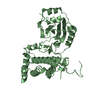
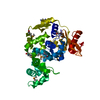
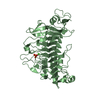
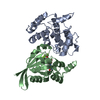
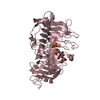




 PDBj
PDBj








